|
Chrysler
|
1925
- |
Country: |
 |
|
ENGINEERING WAS WALTER P. CHRYSLER'S guiding passion and, fortunately for this farmer's boy from America's middle west, the town in which he spent his boyhood - Ellis, Kansas - was the site of a thriving locomotive workshop operated by the Union Pacific Railroad.
Chrysler, born in 1875, started as an engine cleaner, but soon rose to be master mechanic on several middle-west railroads. Soon after the turn of the century, however, internal combustion supplanted steam in his affections, and he decided to become a motor owner.
Instead of starting with a second-hand vehicle, Chrysler set out to buy a brand-new luxury car-with just $700 in the bank. At the 1905 Chicago Automobile Show, he ordered a $5000 Locomobile, borrowed the balance of the purchase money from a banker friend and then went home to tell his wife what he had done.
On The Subject Of The Locomobile, She Said Nothing
'She said nothing,' recalled Chrysler, 'but it seemed as though the kitchen door banged shut a little harder than usual!' In his mid 30's (around 1910) Chrysler became plant manager of the American Locomotive Works, a railway engineering company which had a motor manufacturing subsidiary at Providence, Rhode Island, where carbon copies of the French Berliet car were built under the Alco trademark.
Around this time Chrysler met James J. Storrow of Lee, Higginson & Company, who was heading the bankers' syndicate that had been organised to rescue Billy Durant's ailing General Motors Company - at that time encompassing Buick, Cadillac, Oldsmobile and Oakland (plus a few other concerns).
Storrow must have been impressed by the young railroad engineer's capabilities, for he asked him to join the revitalised General Motors to supply the technical know-how that the syndicate's other nominee, Charles W. Nash (who had just been elected GM president in Durant's stead), was lacking. Even though it meant a drop in salary from $12,000 to $6000 a year, Chrysler accepted the offer, joining General Motors in 1912.
Four years later, he had become President and General Manager of the Buick division, at an annual salary of $500,000, thanks to his immaculate record as a 'cost-conscious executive with a creative grasp of factory techniques', which included the installation of one of the industry's first moving production lines, only a couple of years after Ford. By the end of World War 1, Chrysler had established himself as one of America's top twelve industrialists.
In 1916 Billy Durant had used his success with Chevrolet as a lever to regain control of General Motors and while he had managed to persuade Chrysler to stay on by raising his salary, it was an association that was doomed to break up. Durant had an omnivorous appetite for company acquisitions, and while some of the firms General Motors took over proved to be a worthwhile investment - prime examples being Fisher Bodies and Frigidaire - many were lame ducks whose handicaps bordered on paraplegia.
Chrysler warned against a venture into the manufacture of farm machinery and tractors, but was over-ruled by Durant; it cost the group $30 million to find that Waiter P. had been right and that William C. was wrong. Chrysler, described by a contemporary as 'a glittering personality with a rich railroad man's vocabulary, a short temper and a showman's pride', resigned in disgust. Immediately he was offered the job of saving the ailing Willys-Overland company which, despite a $50 million investment by a group of bankers, was sinking fast. The salary was a cool $1 million annually, but Chrysler earned every penny by putting the company back on a profitable basis; next he was asked to pull Maxwell out of trouble.
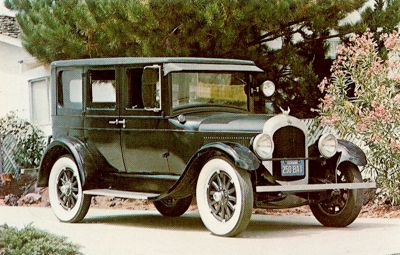 A 1925 Chrysler Imperial Sedan, the first of Chryslers many successes.
A 1925 Chrysler Imperial Sedan, the first of Chryslers many successes.
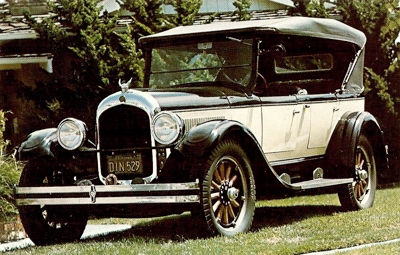 A 1925 Chrysler Six Phaeton.
A 1925 Chrysler Six Phaeton.
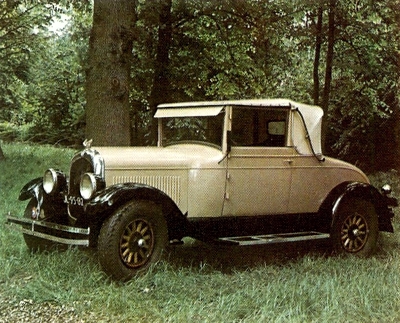 1926 Chrysler Six Roadster.
1926 Chrysler Six Roadster.
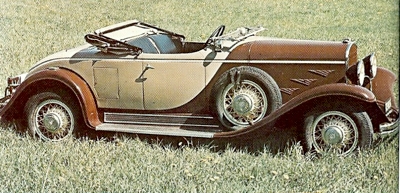 1930 Chrysler Type 77.
1930 Chrysler Type 77.
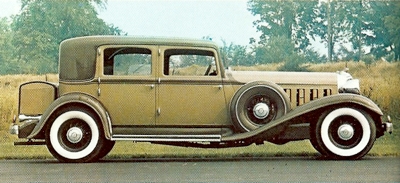 1932 Chrysler Custom Imperial Sedan.
1932 Chrysler Custom Imperial Sedan.
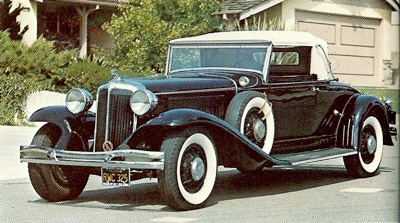 1934 Chrysler Custom Imperial Roadster.
1934 Chrysler Custom Imperial Roadster.
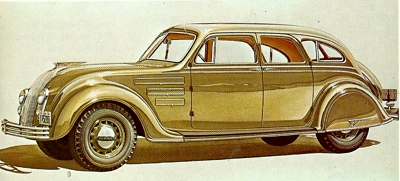 1934 Chrysler Airflow Custom Imperial Sedan.
1934 Chrysler Airflow Custom Imperial Sedan.
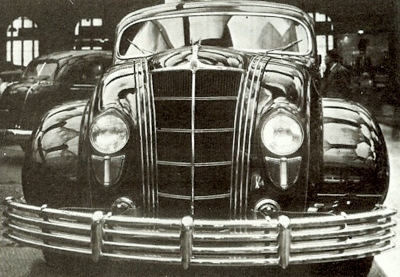 1935 Chrysler Airflow.
1935 Chrysler Airflow.
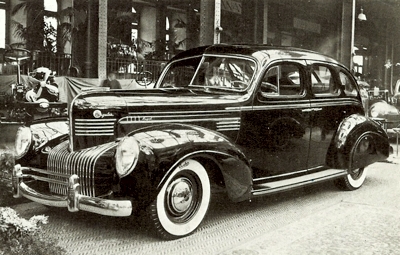 1938 Chrysler Custom Imperial Sedan.
1938 Chrysler Custom Imperial Sedan.
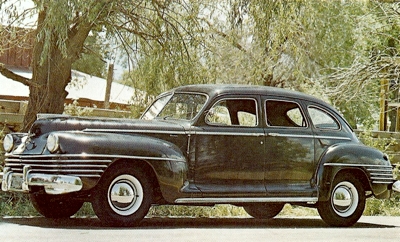 1941 Chrysler Windsor Sedan.
1941 Chrysler Windsor Sedan.
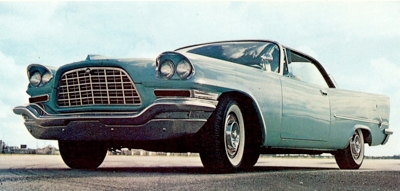 1957 Chrysler 300C.
1957 Chrysler 300C.
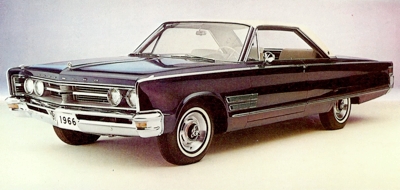 1966 Chrysler 300 Hardtop, which was fitted with a 6.4 liter engine good for 330bhp @ 4800 rpm.
1966 Chrysler 300 Hardtop, which was fitted with a 6.4 liter engine good for 330bhp @ 4800 rpm.
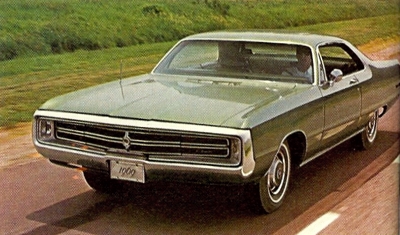 1969 Chrysler 300 V8 Coupe Hardtop.
1969 Chrysler 300 V8 Coupe Hardtop.
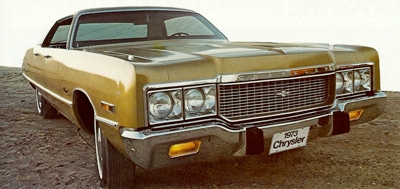 1973 Chrysler Newport Royal, which was fitted with a 6.6 liter V8 developing 185 bhp @ 3600 rpm.
1973 Chrysler Newport Royal, which was fitted with a 6.6 liter V8 developing 185 bhp @ 3600 rpm.
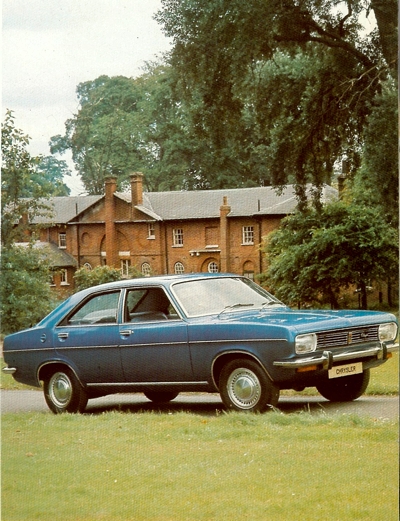 The Chrysler 180 represented all that Chrysler had acquired in the early 1970's. The design was from Coventry in the UK, the manufacture by the Chrysler owned French Simca concern.
The Chrysler 180 represented all that Chrysler had acquired in the early 1970's. The design was from Coventry in the UK, the manufacture by the Chrysler owned French Simca concern. |
Every Mechanical Fault and Every Morning Fix-it
After the war, Maxwell had united with Chalmers: both were popular marques, but a series of marketing mistakes caused sales to slump. Hugh Chalmers had formerly been an ace salesman with the National Cash Register Company, but knew nothing of production; Waiter E. Flanders, president of Maxwell, was a production expert, but a poor engineer. His name had previously been associated with the EMF car, whose nicknames - '
Every Mechanical Fault' and '
Every Morning Fix-it' - epitomised its reputation with motorists. The Maxwells built under his aegis had continued the doubtful tradition; the 1920 models had weak rear axles, which broke with crippling regularity.
The result was a vast stock of unsold cars. Waiter Chrysler cleared the stocks by redesigning the rear axles, and the 'Good Maxwells' quickly regained the marque's lost reputation; by 1923 the losses had been converted into a profit of $2,678,000, and by 1924 the figure had risen to $4 million plus. The revived company was an ideal basis for Chrysler's ultimate ambition -a firm bearing his own name. He had brought three gifted young engineers from Willys-Overland and the trio, Carl Breer, Fred M. Zeder and Owen R. Skelton, began work on a new car that would take advantage of wartime developments in high-compression engine design.
Slippery When Wet
Zeder had already made preliminary studies for a six-cylinder unit with a high-compression cylinder head that seemed to owe more than a little to the work of the British engineer Harry Ricardo; this 70 horsepower unit was used in a new model, the Chrysler Six, marketed under the Maxwell banner. To match its 70 mph performance, unique for a car in its price and capacity bracket, the new model was fitted with four-wheel hydraulic brakes - an innovation of some magnitude for the ultra-conservative American market. The brakes were, however, of the slippery-when-wet external contracting type, which had long been obsolete in Europe.
Chrysler tried to exhibit an early prototype at the January 1924 New York Motor Show, but was refused because the car was not yet in commercial production, so he leased the lobby of the Hotel Commodore, which was close to the exhibition hall, and where the important members of the press and motor industry met. The car was displayed to good effect, for the attention it aroused brought Waiter Chrysler the offer of a $5 million loan from a banking syndicate, which enabled production to get into full swing, and soon Chrysler Sixes were being shipped to agents all over the United States.
Maxwell and Chalmers Marques Killed Off
At a basic price of $1565, the car sold rapidly, for its power and styling gave the owner the feeling that he was driving a far costlier vehicle. In the first twelve months nearly 32,000 Chryslers were sold, creating an industry sales record of $50 million worth of cars. It was the result Waiter Chrysler had been waiting for. In 1925 he bought Maxwell outright, killed off the Maxwell and Chalmers marques and formed the Chrysler Corporation; sales continued to rise, to the extent that, starting from 32nd place in the American industry in 1924, Chrysler had zoomed to fifth place by 1926, moving into fourth slot the following year, when sales reached nearly 200,000.
Profits over the three- year period were around $46 million, which enabled Chrysler to finance an ambitious plan of factory modernisation and expansion. The range now consisted of a four-cylinder model, the 58, introduced in 1925 to succeed. the Maxwell, and the luxury Imperial Six, priced at $3095, in addition to the 70; by the spring of 1928, Chrysler was confidently planning the introduction of a new, lower-priced model, the De Soto, but the true mass-production market was still closed to him, as he lacked facilities for casting and forging iron and steel, which meant that the company had to buy in a great many components, and so could not maintain the necessary tight control over costs that would enable them to compete with Ford and Chevrolet.
The Dodge Chrysler Merger
To provide the necessary factory capacity would mean an investment of $75 million, an intolerable drain on capital reserves which could only result in the proposed low-priced model carrying an unwarranted price supplement, but if Chrysler delayed his expansion plans, he might lose his position in the industry. The only chance seemed to be a merger with another corporation; that was the opportunity presented to him in May 1928 by Clarence Dillon, representing the bankers in control of the Dodge Brothers Company.
For five days, Chrysler and Dillon argued the terms of a takeover, talking twelve hours a day in a suite in New York's Ritz-Carlton Hotel; finally Chrysler agreed to buy Dodge, although the terms of the deal meant that no cash would actually change hands at that time, for $70 million was paid in Chrysler stock, while the new owner agreed to meet the interest payments on Dodge bonds totalling $56 million.
Chrysler Has Gone Into The Low-Priced Field With The Throttle Wide Open - Time Magazine
To Walter Chrysler, the takeover of Dodge was his greatest single business achievement; he put an able lieutenant, Kaufmann T. Keller, in charge of Dodge, whose factory, reorganised to suit Chrysler philosophies, soon proved a most valuable asset. At Highland Park, Detroit, Zeder was working on the new popular car, which was based on the old Maxwell-inspired Chrysler 54. It was launched in July 1928 as the Plymouth, at a basic price of $670. 'Chrysler has gone into the low-priced field with the throttle wide open,' commented
Time, and while Plymouth sales were initially hardly likely to set Lake Michigan afire, by May 1929 output was running at 1000 cars daily.
In 1928 Chrysler emphasised the performance and reliability of the six-cylinder models by entering a brace of tourers at Le Mans; although the battle for first place, between Bentley and Stutz, stole all the headlines, the achievement of the two Chryslers in coming third and fourth was none the less remarkable. By now, the marque had acquired a reputation for innovation, and the narrow-shell 'ribbon' radiators of the 1929 models were widely copied by European makers; internal-expanding hydraulic brakes were a further feature of the range.
For 1931, however, there was a new look: styling was obviously inspired by the long, Iow look of the L29 Cord, as was the gently-vee'd radiator shell. Two new straight-eights, the 40-125 hp Imperial 6.3-liter and the 29-80 bhp 3.9-liter, were introduced, in conjunction with the established 4.4-liter Model 70 and the economy 2.6-Iitre Light Six model. The three larger cars had four-speed 'silent-third' gearboxes.
The Streamliners
Research and experiment had always been an important facet of the Chrysler Corporation's activities, but at the height of the Depression, Walter Chrysler proposed closing down the research department as an economy measure. However, an ex-Ford engineer, Harold Hicks, who joined Chrysler's research team in 1932, had been carrying out streamlining experiments which proved that altering the bodywork of a car to give a smoother airflow could raise top speed from 83 to 98 mph and cut fuel consumption.
Told of this, Chrysler is reported to have remarked: 'Well, if that's what research will do, we must always have research'. It was research which was responsible for features such as the flexible 'Floating Power' engine mountings of the 1932 models, which also had automatic clutches and freewheels, while the announcement of synchromesh in 1933 (early adoption, not invention, which was the domain of
Cadillac) was followed by automatic overdrive for 1934.
More Effieicent Going Backwards
Research also led to the introduction, in 1934, of the controversial
Airflow range. Carl Breer had reportedly found, by wind-tunnel tests, that the average car of the early 1930s was more efficient, aerodynamically, going backwards - so he set out to design a 'back-to-front' car. The result was a technical success-and a commercial flop. The
Airflow had a wide, fully streamlined body whose steel-tube frame was welded to the chassis frame, while forward mounting of the engine reversed the traditional concept of weight distribution by putting 55 per cent of the car's weight on the front axle; long springs were intended to give a 'floating' ride.
However, the front-end styling proved to be too radical a step for the customers to take, although the Corporation's more conventional models, which shared the Airflow's full-width styling with spatted rear wheels from the scuttle back, apparently sold well. So, for 1936, a dummy vee-bonnet was fitted to the Airflow range. The range was shelved after 1937, but technical progress continued under the skin of the other models with the adoption of independent front suspension in 1937, and of steering-column gearchange and optional fluid drive in 1939.
While the Airflow fiasco is well remembered by automotive historians to this day, it was no more than a mild ripple in the smooth progress of Chrysler's corporate success. Indeed, in 1933, the Chrysler group overtook Ford to move into second place behind Chevrolet in total sales, a position it was to hold until 1950. With the company he had founded ten years before firmly established, and with the outstanding debts, incurred at the time of the Dodge takeover, fully paid, WaIter P. Chrysler retired; he died in 1940.
The Town and Country
He was succeeded as president of the corporation by K. T. Keller, who held the post until 1950. Chrysler styling had received a facelift in 1942, with full-width wrap-round grilles, while a new model, the limited-production 'Town and Country', with external wood body framing, restored something of the marque's lost glamour. Even the continuation of the Town and Country line after the war couldn't disguise the fact that Chrysler body styling was beginning to look a little dated by the end of the 1940s; in 1950 the corporation slipped back into third place.
The Hemi-Head V8
Again, it was the marque's engineering that drew attention away from its styling shortcomings: in 1951 the company announced its first V8, a 331 cu in hemi-head with automatic transmission, which was, at the time of its announcement, America's most powerful production car. Another V8, of 301 cu in, replaced the near- traditional L-head six in the sales catalogues in 1955; that year also saw the new 'Flight Sweep' styling that was to boost sales once more.
The Plymouth Gas Turbine
Experiments with gas-turbine propulsion, in 1954, led to a limited production run of 50 Plymouth jet cars in 1964 'for evaluation purposes'. Technical progress continued with the introduction of unit body/chassis construction and alternators in 1960, while the V8 engines, which had become universal on the entire range, became increasingly powerful - and a favorite power unit for European luxury cars like
Jensen,
Bristol and Facel Vega.
But the real progress of the marque in the 1960s and 1970s was in the field of international expansion. There had been a small assembly operation in Britain since the 1920s, but now Chrysler began to look around for a more ambitious bridgehead. They found it in the Rootes Group, which owned
Humber,
Hillman,
Singer and
Sunbeam; Rootes had embarked on an ambitious expansion programme, and welcomed the injection of a substantial amount of Chrysler capital and technical expertise.
The initial agreement was concluded in August 1964; in January 1967 the Rootes board reported that in view of a continuing capital expenditure programme, running into millions of pounds, an even closer association with Chrysler would benefit both the national economy and the Rootes Group. So proposals for Chrysler, which acquired its initial stake for £27 million, to invest a further £20 million were accepted; early in 1973 the group, which had become known as Chrysler United Kingdom Limited in 1970, became a wholly-owned subsidiary of the Chrysler Corporation.
In common with several other competing sections of the British motor industry, Chrysler UK was badly hit by economic and labour problems in the early seventies. The Government eventually stepped.in with financial aid in 1975, to help the re-organised company produce the new
Anglo-French Alpine (a reflection of the Corporation's acquisition of Simca) in England. Indeed, Chrysler's international activities seemed to be parallelling those of the other 'Big-Three' American companies, Ford and GM: the Corporation's programme of investment and development enabling it to 'build up a world-wide company network.
Lee Iacocca
In 1978, Lee Iacocca, recently fired from being Ford's executive, was aggressively courted and brought in as CEO. At the time, Chrysler was losing millions, largely due to recalls of the company's Dodge Aspen and Plymouth Volare, cars that Iacocca would later claim should never have been built. He began rebuilding the entire company from the ground up, laying off many workers, selling the loss-making Chrysler Europe division to Peugeot, and bringing in many former associates from his former company.
Also from Ford, Iacocca brought to Chrysler the "Mini-Max" project, which would bear fruit in 1983 with the successful Dodge Caravan and Plymouth Voyager. Henry Ford II had wanted nothing to do with the Mini-Max, a restyled version of the minivan that Toyota was selling in huge numbers in Asia and Latin America, which doomed the project at Ford. Hal Sperlich, the driving force behind the Mini-Max at Ford had been fired a few months before Iacocca and was waiting for him at Chrysler, where the two would make automotive history.
Iacocca proved to be a capable public spokesman, appearing in advertisements to advise customers that "If you find a better car, buy it." He would also provide a rallying point for Japan-bashing and instilling pride in American products. His book Talking Straight was a response to Akio Morita's Made in Japan. Iacocca arrived shortly after the introduction of the subcompact Dodge Omni and Plymouth Horizon. The front-wheel drive Omni and Horizon became instant hits, selling over 300,000 units each in their debut year, showing what was to come for Chrysler. Ironically, the Omni and Horizon had been designed alongside the Chrysler Horizon with much input from the Chrysler Europe division of the company, which Iacocca axed in 1978.
1980's And Government Loan Guarantees
Realizing that the company would go out of business if it did not receive a significant amount of money to turn the company around, Iacocca approached the United States Congress on September 7, 1979 and asked for US$1.5 billion in loan guarantees. Congress reluctantly passed the "Chrysler Corporation Loan Guarantee Act of 1979" (Public Law 96-185) on December 20, 1979 (signed into law by President Jimmy Carter on January 7, 1980), prodded by Chrysler workers and dealers in every congressional district who feared the loss of their livelihoods.
The military then bought thousands of Dodge pickup trucks which entered military service as the Commercial Utility Cargo Vehicle M-880 Series. With such help and a few innovative cars, Chrysler would manage to avoid bankruptcy and slowly recover. After receiving this reprieve, Chrysler released the first of the K-Car line, the Dodge Aries and Plymouth Reliant, in 1981. Like the minivan which would come later, these compact automobiles were based on design proposals that Ford had rejected during Iacocca's (and Sperlich's) tenure there. Since they were released in the middle of the major 1980-1982 recession, these small, efficient and inexpensive, front-wheel drive cars sold rapidly.
In February 1982 Chrysler announced the sale of Chrysler Defense, its profitable defense subsidiary to General Dynamics for US$348.5 million. The sale was completed in March 1982 for the revised figure of US$336.1 million. Chrysler also introduced the minivan, which was by and large Sperlich's "baby," in the fall of 1983, which led the automobile industry in sales for 25 years. Because of the K-cars and minivans, along with the reforms Iacocca implemented, the company turned around quickly and by 1983, was able to repay the government-backed loans several years ahead of time, resulting in a profit of $350 million to the U.S. government. A joint venture with Mitsubishi called Diamond Star Motors strengthened the company's hand in the small car market. Chrysler also acquired American Motors Corporation (AMC) in 1987, primarily for its Jeep brand, although the failing Eagle Premier would be the basis for the Chrysler LH platform sedans. This bolstered the firm, although Chrysler was still the weakest of the Big Three. In 1987, Chrysler surprised the industry by purchasing Italian sports car maker Lamborghini, with the acquisition heavily driven by Iacocca. Lamborghini would subsequently be sold off in 1994.
Aside from small cars, Iacocca re-introduced the big Imperial as a company's flagship, new model had all of the newest technologies of the time - including fully electronic fuel injection (the first car in the U.S. to be so equipped) and all digital dashboard. Iacocca was also responsible for Chrysler's acquisition of AMC in 1987, which brought the profitable Jeep division under Chrysler's corporate umbrella. It also created the short-lived Eagle division, formed from the remnants of AMC. By this time, AMC had already finished most of the work with the Jeep Grand Cherokee, which Iacocca desperately wanted. The Grand Cherokee would not be released until 1992 for the 1993 model year. That same year, Iacocca stepped down President, CEO and Chairman of Chrysler at the end of 1992.
In the early 1990s, Chrysler made its first steps back into Europe, setting up car production in Austria, and beginning right hand drive manufacture of certain Jeep models in a 1993 return to the UK market. The continuing popularity of Jeep, bold new models for the domestic market such as the Dodge Ram pickup, Dodge Viper (badged as "Chrysler Viper" in Europe) sports car, and Plymouth Prowler hot rod, and new "cab forward" front-wheel drive LH sedans put the company in a strong position as the decade waned. In 1995, former CEO Lee Iacocca assisted in billionaire Kirk Kerkorian's hostile takeover of Chrysler, which was ultimately unsuccessful. The next year, Kerkorian and Chrysler made a five-year agreement that includes a gag order preventing Iacocca from speaking publicly about Chrysler.
Daimler-Benz Partnership
In 1998 Daimler-Benz purchased Chrysler, forming DaimlerChrysler AG. Chrysler Corporation then was legally renamed DaimlerChrysler Motors Company LLC, while its total operations began doing business as Chrysler Group. This was initially declared to be a merger of equals, but it became evident that once Chrylser Chairman and CEO Bob Eaton retired, that Daimler would take majority control.[26] Other executives like President Thomas T. Stallkamp, once considered the heir-apparent of Eaton, and Vice-Chairman Robert Lutz were soon forced out. Eaton, Stallkamp, and Lutz had been described as the "triumvirate" responsible for Chrysler's successes in the late 1990s, with much credit going to Lutz's platform design teams.
Then-Daimler-Benz CEO Juergen Schrempp had "promised a marriage made in heaven and huge synergies". However, it proved to be a disaster for Daimler, which poured billions of dollars into Chrysler, draining management and resources, and repeatedly dragging down its Mercedes-Benz luxury vehicle subsidiary. Chrysler President James P. Holden was responsible for misjudging the launch of the all-new 2001 minivan that resulted in an expensive surplus of 2000 models, losing considerable market share to rivals (Chrysler had created and long dominated the minivan market), and also underestimated demand for the surprisingly popular PT Cruiser, resulting in a $512 million third-quarter loss in 2000 that led to his firing later that year.
Dieter Zetsche was appointed CEO of the Chrysler Group in 2000. The Plymouth brand was phased out in 2001, and plans for cost cutting by sharing of platforms and components began. The Mercedes-based Chrysler Crossfire was one of the first results of this program. A return to rear-wheel drive was announced, and in 2004 a new line of full size cars, spearheaded by the Chrysler 300 using some Mercedes-Benz technology and a new HEMI V8 engine appeared and was successful. The partnership with Mitsubishi was dissolved as DaimlerChrysler divested its stake in the firm. Financial performance improved and Chrysler was generating a significant part of Daimler-Chrysler's profits from 2004–05, as the other subsidiary, Mercedes-Benz, incurred costs for restructuring. By 2005, Chrysler was said to be the healthiest of the Detroit Three automakers (compared to General Motors and Ford Motor Company).
As a result of Zetsche's apparent success in a turnaround of Chrysler, Juergen Schrempp, the CEO of parent company Daimler-Chrysler, was pressured to retire early. Zetsche was elevated to CEO of Daimler-Chrysler on January 1, 2006, and Thomas W. LaSorda became President and CEO of Chrysler Group. However, in 2006, while DCX's other subsidiary Mercedes-Benz turned a profit, Chrysler swung to a loss and analysts believed that the profitable years of 2004-05 would be unlikely to be return in the future. That led to suggestions that the eight-year merger would come to an end, as Mercedes (which made up around 33% of Daimler's $200 billion in 2006 revenues) did not get any competitive boost from Chrysler, and that Daimler would be a stronger and more profitable group without the U.S. unit. Zetsche admitted that Chrysler offered no serious scale of advantages, though he initially insisted a spinoff was not being considered and said that management's first priority is to fix the problems at Chrysler by trimming production and redoubling efforts to boost its competitiveness.
Some suggest that Detsche's tenure was a mixed success, with Chrysler still relying heavily on gas-guzzling SUVs, and most of its product lineup was unsuccessful, despite using Mercedes-derived technologies. Despite radical restructuring and improved models, analysts said that it was difficult to expect a solid recovery at Chrysler, due to the negative dynamics of the U.S. auto market and Chrysler's legacy labor and health care costs. In 2006, Zetsche had starred in the "Dr. Z" ad campaign which cast him as an all-knowing, German-accented wizard of the auto industry, in TV spots and a website. The strategy was to communicate that Chrysler was backed up by the same Teutonic know-how and discipline that has long made Mercedes-Benz one of the world's most prestigious brands. However, the campaign was moth-balled in 2007. Eight years after the merger, most customers did not know that Chrysler was owned by the same company that also produced Mercedes-Benz luxury cars. Some surveyed thought Zetsche was so smooth on screen - even to the point of head-butting a soccer ball perfectly in one take - that he was an actor and not the actual CEO.
